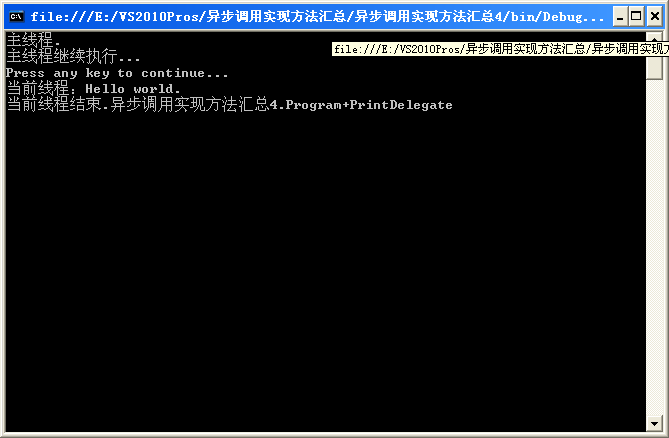最近很忙,既要外出找工作又要兼顾老板公司的项目。今天在公司,忙里偷闲,总结一下.NET中的异步调用函数的实现方法,DebugLZQ在写这篇博文之前自己先动手写了本文的所有示例代码,开写之前是做过功课的,用代码说话方有说服力。
本文的内容旨在用最简洁的代码来把异步调用的方法说清楚,园子里的高手老鸟可以绕行,不喜勿喷,非诚勿扰~
lz的前一篇文章简单的说了下异步,主要是从理解上来讲;这篇文章主要写具体的实现方法。实现异步编程有4种方法可供选择,这4种访求实际上也对应着4种异步调用的模式,分为“等待”和“回调”两大类。四种方法,我在代码中都进行了详细的注释,这里不罗嗦了,直接用代码说明吧
第一种方法:BeginEnvoke EndEnvoke方法,属于“等待”类。using System;using System.Collections.Generic;using System.Linq;using System.Text;using System.Threading;namespace 异步调用实现方法汇总{/// <summary>/// 异步调用方法总结:/// 1.BeginEnvoke EndEnvoke/// 当使用BeginInvoke异步调用方法时,如果方法未执行完,EndInvoke方法就会一直阻塞,直到被调用的方法执行完毕/// </summary>class Program{public delegate void PrintDelegate(string s);static void Main(string[] args){PrintDelegate printDelegate = Print;Console.WriteLine("主线程");IAsyncResult result= printDelegate.BeginInvoke("Hello World.", null, null);Console.WriteLine("主线程继续执行...");//当使用BeginInvoke异步调用方法时,如果方法未执行完,EndInvoke方法就会一直阻塞,直到被调用的方法执行完毕printDelegate.EndInvoke(result);Console.WriteLine("Press any key to continue...");Console.ReadKey(true);}public static void Print(string s){Console.WriteLine("异步线程开始执行:"+s);Thread.Sleep(5000);}}}需要注意的地方,代码中都有注明了,程序运行结果如下:
 第二种方法:WaitOne。同样属于“等待”类。
第二种方法:WaitOne。同样属于“等待”类。using System;using System.Collections.Generic;using System.Linq;using System.Text;using System.Threading;namespace 异步调用实现方法汇总2{/// <summary>/// 异步调用方法总结:/// 2.WaitOne/// 可以看到,与EndInvoke类似,只是用WaitOne函数代码了EndInvoke而已。/// </summary>class Program{public delegate void PrintDelegate(string s);static void Main(string[] args){PrintDelegate printDelegate = Print;Console.WriteLine("主线程");IAsyncResult result = printDelegate.BeginInvoke("Hello World.", null, null);Console.WriteLine("主线程继续执行...");result.AsyncWaitHandle.WaitOne(-1, false);Console.WriteLine("Press any key to continue...");Console.ReadKey(true);}public static void Print(string s){Console.WriteLine("异步线程开始执行:" + s);Thread.Sleep(5000);}}}需要注意的地方,代码中都有注明了,程序运行结果如下:
 第三种方法:轮询。也是属于“等待”类。
第三种方法:轮询。也是属于“等待”类。 using System;using System.Collections.Generic;using System.Linq;using System.Text;using System.Threading;namespace 异步调用实现方法汇总3{/// <summary>/// 异步调用方法总结:/// 3.轮询/// 之前提到的两种方法,只能等下异步方法执行完毕,/// 在完毕之前没有任何提示信息,整个程序就像没有响应一样,用户体验不好,/// 可以通过检查IasyncResult类型的IsCompleted属性来检查异步调用是否完成,/// 如果没有完成,则可以适时地显示一些提示信息/// </summary>class Program{public delegate void PrintDelegate(string s);static void Main(string[] args){PrintDelegate printDelegate = Print;Console.WriteLine("主线程:"+Thread.CurrentThread.ManagedThreadId );IAsyncResult result = printDelegate.BeginInvoke("Hello world.", null, null);Console.WriteLine("主线程:" + Thread.CurrentThread.ManagedThreadId + ",继续执行...");while (!result.IsCompleted){Console.WriteLine(".");Thread.Sleep(500);}Console.WriteLine("主线程:" + Thread.CurrentThread.ManagedThreadId + " Press any key to continue...");Console.ReadKey(true);}public static void Print(string s){Console.WriteLine("当前线程:" + Thread.CurrentThread.ManagedThreadId + s);Thread.Sleep(5000);}}}需要注意的地方,代码中都有注明了,程序运行结果如下:
 第四种方法:回调。当然属于“回调”类。推荐!!!!
第四种方法:回调。当然属于“回调”类。推荐!!!!之前三种方法者在等待异步方法执行完毕后才能拿到执行的结果,期间主线程均处于等待状态。回调和它们最大的区别是,在调用BeginInvoke时只要提供了回调方法,那么主线程就不必要再等待异步线程工作完毕,异步线程在工作结束后会主动调用我们提供的回调方法,并在回调方法中做相应的处理。
using System;using System.Collections.Generic;using System.Linq;using System.Text;using System.Threading;namespace 异步调用实现方法汇总4{/// <summary>/// 异步调用方法总结:/// 4.回调/// 之前三种方法者在等待异步方法执行完毕后才能拿到执行的结果,期间主线程均处于等待状态。/// 回调和它们最大的区别是,在调用BeginInvoke时只要提供了回调方法,那么主线程就不必要再等待异步线程工作完毕,/// 异步线程在工作结束后会主动调用我们提供的回调方法,并在回调方法中做相应的处理,例如显示异步调用的结果。/// </summary>class Program{public delegate void PrintDelegate(string s);static void Main(string[] args){PrintDelegate printDelegate = Print;Console.WriteLine("主线程.");printDelegate.BeginInvoke("Hello world.", PrintComeplete, printDelegate);Console.WriteLine("主线程继续执行...");Console.WriteLine("Press any key to continue...");Console.ReadKey(true);}public static void Print(string s){ Console.WriteLine("当前线程:"+s);Thread.Sleep(5000);}//回调方法要求//1.返回类型为void//2.只有一个参数IAsyncResultpublic static void PrintComeplete(IAsyncResult result){(result.AsyncState as PrintDelegate).EndInvoke(result);Console.WriteLine("当前线程结束." + result.AsyncState.ToString());}}}需要注意的地方,代码中都有注明了,程序运行结果如下:

通过EndInvoke方法得到同步函数的返回值。上面的同步方法返回值为void,我们给个例子:
using System.Diagnostics;using System.Threading;using System.Windows;namespace TestDelegateWrapper{/// <summary>/// Interaction logic for MainWindow.xaml/// </summary>public partial class MainWindow : Window{public MainWindow(){InitializeComponent();}private void ButtonBase_OnClick(object sender, RoutedEventArgs e){WrapperSyncMethodAsync("ABC");Trace.WriteLine("Main thread continue...");}private delegate string SyncMethod1Delegate(string str);private void WrapperSyncMethodAsync(string str){SyncMethod1Delegate syncMethod1Delegate = SyncMethod1;syncMethod1Delegate.BeginInvoke(str, x =>{var result= syncMethod1Delegate.EndInvoke(x);// using the result to do somethingTrace.WriteLine(result);}, null);}private string SyncMethod1(string str){Thread.Sleep(2000);return str;}}}输出如下:
Main thread continue...
ABC
以上就是四种实现异步调用函数的四种方法,说的很清楚了,就写这么多~希望对大家的学习有所帮助,也希望大家多多支持脚本之家。



